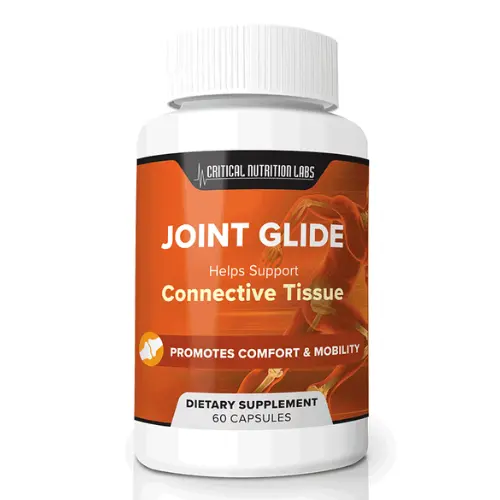Click Here — Official Website — Order Now
⚠️Limited Stock Alert!⚠️
✔For Order Official Website — https://healthshive.com/go-jointglide/
✔Product Name — JointGlide
✔Side Effect — No Side Effects
✔Availability — Online
![Joint Glide [By Critical Nutrition Labs] Promote Joints Comfort And Mobility Naturally. | Joint Glide](https://f4.bcbits.com/img/a2649170319_10.jpg)
Joint glide refers to a type of movement that occurs within a joint, specifically the sliding or gliding motion of one joint surface over another. This motion is an essential component of joint function, allowing for smooth and efficient movement in the body. Joint glides are typically small, involuntary movements that happen in conjunction with other types of motion, such as flexion, extension, or rotation, to facilitate proper biomechanics and reduce friction between the articulating surfaces.
In the context of physical therapy or rehabilitation, joint glides are often manipulated or enhanced to improve joint mobility, particularly when stiffness or restrictions are present. By applying gentle, controlled forces to a joint, a therapist can facilitate the glide of one surface over the other, thereby improving the range of motion and decreasing pain. This technique is especially useful in treating conditions such as arthritis, joint instability, or post-surgical recovery, where the normal gliding movements may be impaired. Understanding joint glides is crucial for ensuring healthy, pain-free movement patterns and preventing long-term joint dysfunction.
➢ ➢ MUST SEE: (EXCLUSIVE OFFER) Click Here to View Pricing & Availability of JointGlide
Uses:
Joint glides have several important uses in both clinical and therapeutic settings, especially for individuals recovering from injuries or surgeries. One of the primary applications is in the treatment of joint stiffness and limited range of motion. When a joint becomes stiff due to immobility, inflammation, or injury, the normal gliding motion of the joint surfaces can be restricted, leading to pain and functional limitations. Therapists use joint gliding techniques to restore the natural movement within the joint, promoting better flexibility and reducing discomfort. For example, in the rehabilitation of a knee after surgery, joint gliding can help improve the knee's ability to bend and straighten smoothly, which is essential for normal walking and other activities.
Another significant use of joint glides is in managing conditions like osteoarthritis, where the cartilage between joint surfaces begins to deteriorate, resulting in friction and pain. By applying joint glides, therapists can help reduce the stress on the affected joint, enhance fluid circulation within the joint, and decrease the sensations of stiffness or tightness. This can provide patients with temporary relief from symptoms, allowing them to engage in daily activities more comfortably. Additionally, joint glides are often integrated into the early stages of post-operative rehabilitation to ensure proper healing of joint tissues and prevent the formation of scar tissue that could further restrict movement. Overall, joint glide techniques play a vital role in maintaining or restoring healthy joint mechanics, improving mobility, and managing pain in a variety of musculoskeletal conditions. How to use:
When writing a paragraph that incorporates the concept of joint glide, it's essential to clearly explain what it is and how it functions within the context you're discussing. Here's a step-by-step approach on how to use the term "joint glide" effectively in your writing:
➢ ➢ MUST SEE: (EXCLUSIVE OFFER) Click Here to View Pricing & Availability of JointGlide
Conclusion:
In conclusion, joint glide is a vital technique used to improve joint mobility and function, particularly in the context of physical therapy and rehabilitation. By facilitating the smooth sliding of joint surfaces, it helps restore range of motion, reduce pain, and enhance overall joint health. Whether it's used to treat conditions like arthritis, assist in post-surgical recovery, or address mobility issues from injury, joint gliding plays a key role in promoting long-term joint stability and pain-free movement. As a non-invasive, effective treatment, it remains an essential tool in supporting individuals to regain and maintain their independence and quality of life.
https://jointglideusa.company.site/
⚠️Limited Stock Alert!⚠️
✔For Order Official Website — https://healthshive.com/go-jointglide/
✔Product Name — JointGlide
✔Side Effect — No Side Effects
✔Availability — Online
![Joint Glide [By Critical Nutrition Labs] Promote Joints Comfort And Mobility Naturally. | Joint Glide](https://f4.bcbits.com/img/a2649170319_10.jpg)
Joint glide refers to a type of movement that occurs within a joint, specifically the sliding or gliding motion of one joint surface over another. This motion is an essential component of joint function, allowing for smooth and efficient movement in the body. Joint glides are typically small, involuntary movements that happen in conjunction with other types of motion, such as flexion, extension, or rotation, to facilitate proper biomechanics and reduce friction between the articulating surfaces.
In the context of physical therapy or rehabilitation, joint glides are often manipulated or enhanced to improve joint mobility, particularly when stiffness or restrictions are present. By applying gentle, controlled forces to a joint, a therapist can facilitate the glide of one surface over the other, thereby improving the range of motion and decreasing pain. This technique is especially useful in treating conditions such as arthritis, joint instability, or post-surgical recovery, where the normal gliding movements may be impaired. Understanding joint glides is crucial for ensuring healthy, pain-free movement patterns and preventing long-term joint dysfunction.
➢ ➢ MUST SEE: (EXCLUSIVE OFFER) Click Here to View Pricing & Availability of JointGlide
Uses:
Joint glides have several important uses in both clinical and therapeutic settings, especially for individuals recovering from injuries or surgeries. One of the primary applications is in the treatment of joint stiffness and limited range of motion. When a joint becomes stiff due to immobility, inflammation, or injury, the normal gliding motion of the joint surfaces can be restricted, leading to pain and functional limitations. Therapists use joint gliding techniques to restore the natural movement within the joint, promoting better flexibility and reducing discomfort. For example, in the rehabilitation of a knee after surgery, joint gliding can help improve the knee's ability to bend and straighten smoothly, which is essential for normal walking and other activities.
Another significant use of joint glides is in managing conditions like osteoarthritis, where the cartilage between joint surfaces begins to deteriorate, resulting in friction and pain. By applying joint glides, therapists can help reduce the stress on the affected joint, enhance fluid circulation within the joint, and decrease the sensations of stiffness or tightness. This can provide patients with temporary relief from symptoms, allowing them to engage in daily activities more comfortably. Additionally, joint glides are often integrated into the early stages of post-operative rehabilitation to ensure proper healing of joint tissues and prevent the formation of scar tissue that could further restrict movement. Overall, joint glide techniques play a vital role in maintaining or restoring healthy joint mechanics, improving mobility, and managing pain in a variety of musculoskeletal conditions. How to use:
When writing a paragraph that incorporates the concept of joint glide, it's essential to clearly explain what it is and how it functions within the context you're discussing. Here's a step-by-step approach on how to use the term "joint glide" effectively in your writing:
- Introduction to the concept: Start by defining or briefly explaining what joint glide is, especially if the audience might not be familiar with the term. This ensures clarity and context for your readers.
Example: "Joint glide refers to the small, controlled sliding motions that occur between the surfaces of two articulating bones within a joint." - Contextualize its application: Once defined, explain how joint glide is applied in real-life scenarios, such as in physical therapy or rehabilitation. This adds depth to your explanation and shows its relevance.
Example: "In physical therapy, joint glide is commonly used to restore the full range of motion in a stiff or injured joint, such as the knee or shoulder, by gently moving the surfaces of the joint in a controlled manner." - Expand on its uses: Detail the specific benefits or therapeutic uses of joint glide, emphasizing how it helps in rehabilitation or pain management. This can be where you mention particular conditions or injuries that benefit from joint gliding techniques.
Example: "For individuals recovering from knee surgery, joint glides are particularly beneficial as they help improve the smooth sliding of joint surfaces, which can speed up recovery and reduce post-surgical stiffness." - Conclude with its importance: End the paragraph by reinforcing why joint glide is important and how it contributes to overall health and mobility.
Example: "By enhancing joint mobility, joint glides play a crucial role in helping patients regain strength and function, ultimately improving their ability to perform everyday tasks without pain."
➢ ➢ MUST SEE: (EXCLUSIVE OFFER) Click Here to View Pricing & Availability of JointGlide
Conclusion:
In conclusion, joint glide is a vital technique used to improve joint mobility and function, particularly in the context of physical therapy and rehabilitation. By facilitating the smooth sliding of joint surfaces, it helps restore range of motion, reduce pain, and enhance overall joint health. Whether it's used to treat conditions like arthritis, assist in post-surgical recovery, or address mobility issues from injury, joint gliding plays a key role in promoting long-term joint stability and pain-free movement. As a non-invasive, effective treatment, it remains an essential tool in supporting individuals to regain and maintain their independence and quality of life.
https://jointglideusa.company.site/




